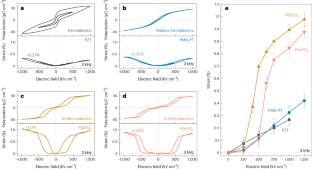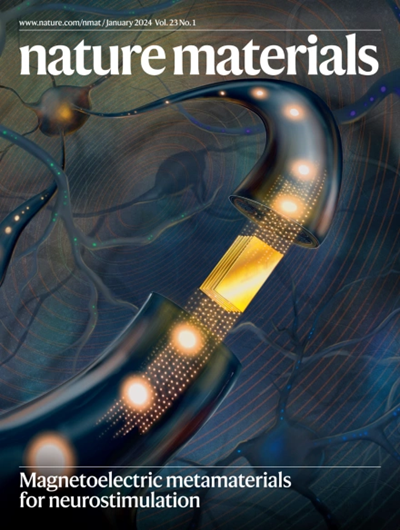钳位可增强反铁电薄膜的机电响应
IF 37.2
1区 材料科学
Q1 CHEMISTRY, PHYSICAL
引用次数: 0
摘要
具有较大机电响应的薄膜材料是下一代微米/纳米机电应用的基础材料。然而,传统的机电材料(如铁电材料和弛豫器)在缩减到亚微米厚的薄膜时,由于基底的限制(箝位),会表现出严重的响应衰减。反铁电薄膜克服了这一限制,通过场诱导的反铁电到铁电相变与基底约束的非常规耦合,实现了巨大的机电响应。利用操作电子显微镜观察到氧八面体的脱硅和晶格体积在所有维度上的膨胀与相变相一致,因此面内夹持进一步增强了面外膨胀,第一原理计算也证明了这一点。反过来,还实现了非传统的厚度缩放,即从厚度仅为 100 纳米的模型反铁电 PbZrO3 薄膜中产生机电应变(1.7%)。高性能和对机理的理解为开发高性能微米/纳米机电系统提供了一条大有可为的途径。本文章由计算机程序翻译,如有差异,请以英文原文为准。


Clamping enables enhanced electromechanical responses in antiferroelectric thin films
Thin-film materials with large electromechanical responses are fundamental enablers of next-generation micro-/nano-electromechanical applications. Conventional electromechanical materials (for example, ferroelectrics and relaxors), however, exhibit severely degraded responses when scaled down to submicrometre-thick films due to substrate constraints (clamping). This limitation is overcome, and substantial electromechanical responses in antiferroelectric thin films are achieved through an unconventional coupling of the field-induced antiferroelectric-to-ferroelectric phase transition and the substrate constraints. A detilting of the oxygen octahedra and lattice-volume expansion in all dimensions are observed commensurate with the phase transition using operando electron microscopy, such that the in-plane clamping further enhances the out-of-plane expansion, as rationalized using first-principles calculations. In turn, a non-traditional thickness scaling is realized wherein an electromechanical strain (1.7%) is produced from a model antiferroelectric PbZrO3 film that is just 100 nm thick. The high performance and understanding of the mechanism provide a promising pathway to develop high-performance micro-/nano-electromechanical systems. Here, the authors observe that in thin films of antiferroelectric PbZrO3, substrate clamping enhances the electromechanical response, with expansion purely in the out-of-plane direction, achieving 1.7% strain for 100-nm-thick films.
求助全文
通过发布文献求助,成功后即可免费获取论文全文。
去求助
来源期刊

Nature Materials
工程技术-材料科学:综合
CiteScore
62.20
自引率
0.70%
发文量
221
审稿时长
3.2 months
期刊介绍:
Nature Materials is a monthly multi-disciplinary journal aimed at bringing together cutting-edge research across the entire spectrum of materials science and engineering. It covers all applied and fundamental aspects of the synthesis/processing, structure/composition, properties, and performance of materials. The journal recognizes that materials research has an increasing impact on classical disciplines such as physics, chemistry, and biology.
Additionally, Nature Materials provides a forum for the development of a common identity among materials scientists and encourages interdisciplinary collaboration. It takes an integrated and balanced approach to all areas of materials research, fostering the exchange of ideas between scientists involved in different disciplines.
Nature Materials is an invaluable resource for scientists in academia and industry who are active in discovering and developing materials and materials-related concepts. It offers engaging and informative papers of exceptional significance and quality, with the aim of influencing the development of society in the future.
 求助内容:
求助内容: 应助结果提醒方式:
应助结果提醒方式:


